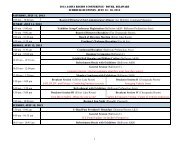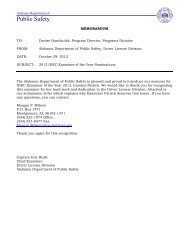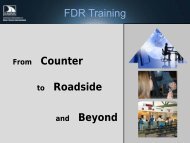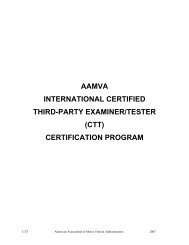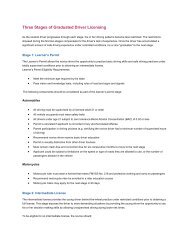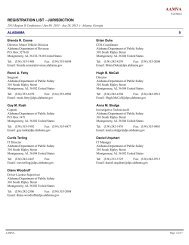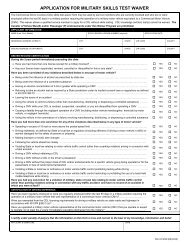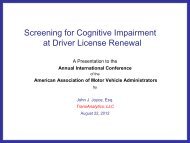Best Practices for Title and Registration of A New Motorcycle ...
Best Practices for Title and Registration of A New Motorcycle ...
Best Practices for Title and Registration of A New Motorcycle ...
You also want an ePaper? Increase the reach of your titles
YUMPU automatically turns print PDFs into web optimized ePapers that Google loves.
TABLE OF CONTENTSExecutive Overview......................................................................................................... 1Definitions ....................................................................................................................... 2<strong>Best</strong> <strong>Practices</strong> <strong>for</strong> Issuance <strong>of</strong> A Certificate <strong>of</strong> <strong>Title</strong> <strong>and</strong> <strong>Registration</strong> <strong>for</strong> A <strong>New</strong><strong>Motorcycle</strong>....................................................................................................................... 3Attachment A - Unconventional Vehicles Working Group Charter .................................. 4Attachment B - Board <strong>of</strong> Directors Resolution No. 06-01 ................................................ 6Attachment C – NHTSA Certification Label Requirements <strong>for</strong> <strong>Motorcycle</strong>s .................... 8Attachment D – EPA Certification Requirements <strong>for</strong> <strong>Motorcycle</strong>s ................................. 11Attachment E – NHTSA Declaration.............................................................................. 13Attachment F – EPA Form 3520-1 ................................................................................ 14
Executive OverviewJurisdictions continue to be faced with a variety <strong>of</strong> new vehicle types that are outside <strong>of</strong>the traditional definitions <strong>of</strong> a motor vehicle. The universe <strong>of</strong> unconventional vehiclesrange from the current rage <strong>of</strong> pocket bikes <strong>and</strong> motor scooters to customized trucks<strong>and</strong> truck-tractors that have been converted into RV type vehicles. Roadsideen<strong>for</strong>cement continues to face the challenge <strong>of</strong> how to h<strong>and</strong>le these vehicles <strong>and</strong>operators when they are operated on the highways.In an attempt to assist the jurisdictions, AAMVA chartered the Unconventional VehiclesWorking Group in 2005 (see Attachment A <strong>for</strong> the Charter). The purpose <strong>of</strong> thisWorking Group was to review the problems associated with the variety <strong>of</strong>unconventional vehicles that motor vehicle administrators <strong>and</strong> law en<strong>for</strong>cement <strong>of</strong>ficerscontinue to encounter. The Working Group was tasked with developing guidance <strong>and</strong>resources to assist the jurisdictions with appropriately titling <strong>and</strong> registering thesevehicles <strong>and</strong> appropriately licensing the vehicle operator to ensure safe operation <strong>of</strong> thevehicle on the highways.The initial focus <strong>of</strong> the working group was the pocket bikes <strong>and</strong> scooters. From thework surrounding this issue the AAMVA Board <strong>of</strong> Directors approved Resolution No. 06-01, <strong>Registration</strong> <strong>and</strong> Titling <strong>of</strong> Pocket Bikes in January 2006 (see Attachment B).Due to differing federal requirements <strong>and</strong> terminology, the Working Group determinedthat crafting a best practices document that applies to both the states <strong>and</strong> the Canadianprovinces was not feasible. There<strong>for</strong>e, these <strong>Best</strong> <strong>Practices</strong> were developed to provideguidance to the states. The CCMTA Unusual Vehicles Working Group may follow these<strong>Best</strong> <strong>Practices</strong> with a version that applies to the Canadian provinces.AAMVA strongly encourages jurisdictions to use these <strong>Best</strong> <strong>Practices</strong> to promoteuni<strong>for</strong>mity. Using a common approach would facilitate the movement <strong>of</strong> these vehiclesfrom one jurisdiction to another. These <strong>Best</strong> <strong>Practices</strong> have the capability to grow,change <strong>and</strong> evolve as new vehicle types continue to be introduced.April 4, 20071
DefinitionsFor purposes <strong>of</strong> the <strong>Best</strong> <strong>Practices</strong> <strong>for</strong> <strong>Title</strong> <strong>and</strong> <strong>Registration</strong> <strong>of</strong> A <strong>New</strong> <strong>Motorcycle</strong> thefollowing definitions shall be used:EPA means the Environmental Protection Agency.EPA Certification label means the label attached by the original manufacturer thatcertifies compliance with the Federal Motor Vehicle Emission <strong>and</strong> Fuel St<strong>and</strong>ards.[Source: 42 U.S.C., Section 7541]Manufacturer’s certificate <strong>of</strong> origin means the ownership document issued by themanufacturer or authorized United States distributor that meets the specifications asprovided in AAMVA’s policy titled “Specifications <strong>for</strong> Printing a Manufacturer’sCertificate <strong>of</strong> Origin (CO) <strong>for</strong> Motor Vehicle St<strong>and</strong>ards”.<strong>Motorcycle</strong> means a motor vehicle with motive power having a seat or saddle <strong>for</strong> theuse <strong>of</strong> the rider <strong>and</strong> designed to travel on not more than three wheels in contact with theground. [Source: 49 CFR 571.3]Motor vehicle means a vehicle driven or drawn by mechanical power <strong>and</strong>manufactured primarily <strong>for</strong> use on public streets, roads, <strong>and</strong> highways, but does notinclude a vehicle operated only on a rail line. [Source: 49 U.S.C., Section 30102]NHTSA means the National Highway Traffic Safety Administration.NHTSA Certification label means the label attached by the original manufacturer thatcertifies compliance with the Federal Motor Vehicle Safety St<strong>and</strong>ards. [Source: 49CFR, Section 567.4]VIN (Vehicle Identification Number) means a series <strong>of</strong> Arabic numbers <strong>and</strong> Romanletters that is assigned to a motor vehicle <strong>for</strong> identification purposes pursuant to 49 CFR565.3.April 4, 20072
<strong>Best</strong> <strong>Practices</strong> <strong>for</strong> Issuance <strong>of</strong> A Certificate<strong>of</strong> <strong>Title</strong> <strong>and</strong> <strong>Registration</strong> <strong>for</strong> A <strong>New</strong> <strong>Motorcycle</strong>Prior to issuance <strong>of</strong> an ownership document <strong>for</strong> a new “motorcycle” a jurisdiction shall:1. Determine that the vehicle meets the federal definition <strong>of</strong> “motorcycle” <strong>and</strong> thejurisdiction’s definition <strong>of</strong> motorcycle.2. Require presentation <strong>of</strong> a typed or computer-generated manufacturer’s certificate<strong>of</strong> origin (h<strong>and</strong> written documents shall not be accepted) that does not includeverbiage similar to “<strong>of</strong>f-road use only.” If a jurisdiction issues a certificate <strong>of</strong> title<strong>for</strong> an <strong>of</strong>f-road vehicle, the title document should indicate that the vehicle is noteligible to be registered <strong>for</strong> road use.3. Require that the manufacturer’s certificate <strong>of</strong> origin <strong>and</strong> the motorcycle have aVIN consisting <strong>of</strong> 17 characters assigned by the manufacturer <strong>and</strong> having aNHTSA assigned World Manufacturer Identifier (WMI).4. Verify, by physical inspection or affidavit that the motorcycle bears the requiredNHTSA certification label <strong>and</strong> EPA certification label (see Attachments C <strong>and</strong> D<strong>for</strong> motorcycle NHTSA <strong>and</strong> EPA certification requirements). For importedvehicles, verification that the vehicle meets federal st<strong>and</strong>ards may also be in the<strong>for</strong>m <strong>of</strong> a copy <strong>of</strong> the NHTSA Declaration <strong>for</strong>m (HS-7 - see Attachment E <strong>for</strong> asample <strong>of</strong> the Declaration <strong>for</strong>m) <strong>and</strong> EPA Form 3520-1 (see Attachment F <strong>for</strong> asample <strong>of</strong> the EPA Form 3520-1) or other documentation acceptable to thejurisdiction. To determine if a motorcycle has been imported, a jurisdiction maysearch the Manufacturer’s In<strong>for</strong>mation available on NHTSA’s websitehttp://www.nhtsa.dot.gov/cars/rules/manufacture/. If a jurisdiction is not able toper<strong>for</strong>m a physical inspection or utilize an affidavit, the jurisdiction shouldestablish other acceptable pro<strong>of</strong> or process guidelines to verify that themotorcycle bears the required NHTSA certification label <strong>and</strong> EPA certificationlabel.5. Any vehicle that purports to be a motorcycle but does not meet the requirementslisted above should not be registered <strong>for</strong> on-road use.April 4 20073
Attachment AAmerican Association <strong>of</strong> Motor Vehicle Administrators, Inc.Unconventional Vehicles Working GroupCharterI. NAMEThe name <strong>of</strong> the working group shall be the “Unconventional Vehicle WorkingGroup” here after called the Working Group.II.III.PURPOSE <strong>and</strong> AUTHORITYThe Working Group shall review the problems associated with the variety <strong>of</strong>unconventional vehicles that motor vehicle administrators <strong>and</strong> law en<strong>for</strong>cement<strong>of</strong>ficers continue to encounter. The purpose <strong>of</strong> the review will be to identify <strong>and</strong>develop strategies/policies/best practices to assist member jurisdictions indealing with these types <strong>of</strong> vehicles in a uni<strong>for</strong>m <strong>and</strong> consistent manner. Asdetailed in Section IV <strong>of</strong> the charter, Phase one <strong>of</strong> the review will focus on pocketbikes <strong>and</strong> scooters. Phase two <strong>of</strong> the review will focus on other types <strong>of</strong>unconventional vehicles, including homemade vehicles <strong>and</strong> converted trucks.BACKGROUNDJurisdictions continue to be faced with a variety <strong>of</strong> new vehicle types that areoutside <strong>of</strong> the traditional definitions <strong>of</strong> motor vehicle. In most cases, thesevehicles are not manufactured <strong>for</strong> on road use, but some are being customized inan attempt to make them “street legal”. The universe <strong>of</strong> unconventional vehiclesranges from the current rage <strong>of</strong> pocket bikes <strong>and</strong> motor scooters to customizedtrucks <strong>and</strong> truck-tractors that have been converted into RV type vehicles in anattempt to circumvent CDL <strong>and</strong> truck en<strong>for</strong>cement requirements. Roadsideen<strong>for</strong>cement continues to face the challenge <strong>of</strong> how to h<strong>and</strong>le these vehicle <strong>and</strong>operators when they are found on the highways.Previously, the issue <strong>of</strong> low speed vehicles was identified <strong>and</strong> addressed throughthe ef<strong>for</strong>ts <strong>of</strong> a multi-disciplinary working group. It is intended that this workinggroup will address the concerns that this new universe <strong>of</strong> vehicles presents to ourmembers. The Working Group will develop guidance <strong>and</strong> resources to ensurethat these vehicles are appropriately titled <strong>and</strong> registered <strong>and</strong> the vehicleoperator is appropriately licensed to ensure safe operation <strong>of</strong> the vehicle on thehighways.IV.EXPECTED OUTCOMES/DELIVERABLESThe Working Group will:1. Map the problem from a variety <strong>of</strong> perspectives, develop a comprehensiveunconventional vehicle definition, <strong>and</strong> develop a process model whichApril 4, 20074
including identification <strong>of</strong> short, medium <strong>and</strong> longer term issues. Theinitial focus will be pocket bikes <strong>and</strong> scooters. <strong>Best</strong> practices, policies <strong>and</strong>model legislation (if required) will be developed in the short term <strong>for</strong> thetreatment <strong>of</strong> pocket bikes <strong>and</strong> scooters - Projected completion – August2006.2. Develop a report that outlines a plan <strong>of</strong> action, including milestones, thatwill assist the organization in developing an active process to ensure atimely proactive response to new issues that arise in the unconventionalvehicles arena. – Project completion – September 2007.3. Work on phase two <strong>of</strong> the review (other unconventional vehicles) willfollow the procedures outlined <strong>for</strong> phase one, with deliverables expectednot later than June 1, 2007 – Projected Completion – June 20074. Outcomes/deliverables from phase one <strong>and</strong> phase two will be available <strong>for</strong>discussion during the 2007 AAMVA Regional Conferences <strong>and</strong> AnnualInternational Conference - Projected Completion – September 2007.V. MEMBERSHIPThe Working Group will be chaired by a VRT Steering Committee Member whowill be appointed by the International Chair <strong>of</strong> the Vehicle Committee. The othermembers will include representatives from the following AAMVA disciplines:Legal Service, Driver Licensing <strong>and</strong> Control, Law En<strong>for</strong>cement, Motor CarrierServices, Vehicle <strong>Registration</strong> <strong>and</strong> <strong>Title</strong>, <strong>and</strong> Vehicle Safety <strong>and</strong> Inspection.VI.MEETING PROCEDURESIt is anticipated the Working Group will meet in person be<strong>for</strong>e July 1, 2005 <strong>for</strong> aninitial discussion <strong>of</strong> the issues surrounding unconventional vehicles. Subsequentmeetings will, whenever possible, be conducted via conference calls.Announcement <strong>of</strong> the initial meeting will be broadcast via the VRT Yahoo Group,the LE Yahoo Group, the DL&C Yahoo Group, <strong>and</strong> the VS & I Yahoo Group. Itwill also be posted on the AAMVA website <strong>and</strong> distributed to a variety <strong>of</strong> pertinentassociations <strong>and</strong> organizations.VII.WORKING GROUP TERMINATIONThe Working Group will be dissolved by September 30 th , 2007 unless tasked withadditional responsibilities by the AAMVA Chair <strong>of</strong> the Board or extended by theAAMVA Steering Committee.April 4, 20075
WHEREAS, lack <strong>of</strong> federal regulation, guidance or st<strong>and</strong>ards clearly applicable topocket bikes has created confusion <strong>for</strong> law en<strong>for</strong>cement <strong>of</strong>ficials, motor vehicleadministrators <strong>and</strong> state <strong>and</strong> local government <strong>of</strong>ficials; now, there<strong>for</strong>e, be itResolved by the Board <strong>of</strong> Directors <strong>of</strong> the American Association <strong>of</strong> Motor VehicleAdministrators, that AAMVA finds that, because pocket bikes do not meet federalmotor vehicle safety st<strong>and</strong>ards, they are not ‘manufactured primarily <strong>for</strong> use on publichighways’ within the meaning <strong>of</strong> federal law; <strong>and</strong>BE IT FURTHER RESOLVED that AAMVA shall endeavor to develop <strong>and</strong> strengthenrelationships with other safety organizations <strong>and</strong> law en<strong>for</strong>cement agencies <strong>and</strong> nationalsafety organizations to promote awareness <strong>of</strong> safety concerns <strong>and</strong> insure that statelaws prohibit the operation <strong>of</strong> pocket bikes on public roads; <strong>and</strong>BE IT FURTHER RESOLVED that jurisdictions should not title or register <strong>for</strong> on-roaduse pocket bikes, 'mini-choppers', or any other non-st<strong>and</strong>ard motorcycle that does notmeet federal motor vehicle safety st<strong>and</strong>ards <strong>for</strong> vehicles intended <strong>for</strong> use on publichighways, <strong>and</strong> that lacks the manufacturer's certification label stating that the vehiclemeets all applicable safety st<strong>and</strong>ards in effect on the date <strong>of</strong> manufacture, unless stateor federal law specifically exempts the vehicle from such st<strong>and</strong>ards <strong>and</strong> certification;<strong>and</strong>BE IT FURTHER RESOLVED that AAMVA shall provide this resolution to CPSC,NHTSA, National Traffic Law Center, National Conference <strong>of</strong> State Legislatures,Governors Highway Safety Association <strong>and</strong> other appropriate Federal <strong>and</strong> Stateagencies.______________________________________________________________________Board <strong>of</strong> Directors Resolution 06-01 was passed at a meeting duly held onJanuary 13-14, 2006_________________________Bonnie RutledgeChair <strong>of</strong> the Board <strong>of</strong> Directors_______________________Glenn TurnerSecretary <strong>of</strong> the BoardApril 4, 20077
Attachment CNHTSA Certification Label Requirements <strong>for</strong> <strong>Motorcycle</strong>sA certification label meeting the requirements <strong>of</strong> 49 CFR Part 567 that, among otherthings, identifies the vehicle’s manufacturer (i.e., the actual assembler <strong>of</strong> thevehicle), states the vehicle’s date <strong>of</strong> manufacture (month <strong>and</strong> year), <strong>and</strong> contains thefollowing statement: “This vehicle con<strong>for</strong>ms to all applicable Federal motor vehiclesafety st<strong>and</strong>ards (FMVSS) in effect on the date <strong>of</strong> manufacture shown above.”For vehicles other than motorcycles or trailers, the label must be affixed to either thehinge pillar, door-latch post, or the door edge that meets the door-latch post, next tothe driver’s seating position. For trailers, the label must be affixed to a location onthe <strong>for</strong>ward half <strong>of</strong> the left side <strong>of</strong> the vehicle, so that it can be easily read withoutmoving any part <strong>of</strong> the vehicle. For motorcycles, the label must be affixed to apermanent member <strong>of</strong> the vehicle as close as is practicable to the intersection <strong>of</strong> thesteering post with the h<strong>and</strong>lebars, so that it is easily readable without moving anypart <strong>of</strong> the vehicle except <strong>for</strong> the steering system.SAMPLE LABELMANUFACTURED BY: JOE’S MOTORCYCLESJuly 1997GVWRGAWR FRONTGAWR REAR271 KG (598 LB)110 KG (243 LB) WITH M 120/70R18 TIRE, 18XMT3.00 RIM. AT 250KPA(36 PSI) COLD161 KG (355 LB) WITH M160/60R17 TIRE, 17XMT4.00 RIM. AT 250KPA(36 PSI) COLDTHIS VEHICLE CONFORMS TO ALL APPLICABLE US FEDERAL MOTOR VEHICLE SAFETYSTANDARDS IN EFFECT ON THE DATE OF MANUFACTURE SHOWN ABOVEVIN: WMIXXXXXXXXXXXXXXTYPE: MOTORCYCLE§ 567.4 Requirements <strong>for</strong> manufacturers <strong>of</strong> motor vehicles. (**Modified <strong>for</strong><strong>Motorcycle</strong> <strong>and</strong> Motor-Driven Cycle)(a)(b)(c)Each manufacturer <strong>of</strong> motor vehicles shall affix to each vehicle a label, <strong>of</strong> thetype <strong>and</strong> in the manner described below, containing the statements specified inparagraph (e) <strong>of</strong> this section.The label shall be permanently affixed in such a manner that it cannot beremoved without destroying or defacing it.The label <strong>for</strong> motorcycles shall be affixed to a permanent member <strong>of</strong> the vehicleas close as is practicable to the intersection <strong>of</strong> the steering post with the h<strong>and</strong>leApril 4, 20078
ars, in a location such that it is easily readable without moving any part <strong>of</strong> thevehicle except the steering system.(d)(e)The lettering on the label shall be <strong>of</strong> a color that contrasts with the background <strong>of</strong>the label.The label shall contain the following statements, in the English language, letteredin block capitals <strong>and</strong> numerals not less than three thirty-seconds <strong>of</strong> an inch high,in the order shown:(1) Name <strong>of</strong> manufacturer: Except as provided in paragraphs (e)(1) (i) <strong>and</strong> (ii)<strong>of</strong> this section, the full corporate or individual name <strong>of</strong> the actualassembler <strong>of</strong> the vehicle shall be spelled out, except that suchabbreviations as “Co.” or “Inc.” <strong>and</strong> their <strong>for</strong>eign equivalents, <strong>and</strong> the first<strong>and</strong> middle initials <strong>of</strong> individuals, may be used. The name <strong>of</strong> themanufacturer shall be preceded by the words “Manufactured By” or “MfdBy.”(i)(ii)If a vehicle is assembled by a corporation that is controlled byanother corporation that assumes responsibility <strong>for</strong> con<strong>for</strong>mity withthe st<strong>and</strong>ards, the name <strong>of</strong> the controlling corporation may be used.If a vehicle is fabricated <strong>and</strong> delivered in complete butunassembled (kit) <strong>for</strong>m, such that it is designed to be assembledwithout special machinery or tools, the fabricator <strong>of</strong> the vehicle mayaffix the label <strong>and</strong> name itself as the manufacturer <strong>for</strong> the purposes<strong>of</strong> this section.(2) Month <strong>and</strong> year <strong>of</strong> manufacture: This shall be the time during which workwas completed at the place <strong>of</strong> main assembly <strong>of</strong> the vehicle. It may bespelled out, as “June 1970,” or expressed in numerals, as “6/70.”(3) “Gross Vehicle Weight Rating” or “GVWR,” followed by the appropriatevalue in pounds, which shall not be less than the sum <strong>of</strong> the unloadedvehicle weight, rated cargo load, <strong>and</strong> 150 pounds times the vehicle'sdesignated seating capacity.(4) “Gross Axle Weight Rating” or “GAWR” followed by the appropriate valuein pounds <strong>for</strong> each axle, identified in order from front to rear.(5) The statement: “This vehicle con<strong>for</strong>ms to all applicable Federal motorvehicle safety st<strong>and</strong>ards in effect on the date <strong>of</strong> manufacture shownabove.” The expression “U.S.” or “U.S.A.” may be inserted be<strong>for</strong>e the word“Federal.”April 4, 20079
(6) Vehicle identification number.(7) The type classification <strong>of</strong> the vehicle as defined in §571.3 <strong>of</strong> this chapter(motorcycle or motor-driven cycle).Additional in<strong>for</strong>mation about motorcycle manufacturer requirements can be found at:http://www.nhtsa.dot.gov/cars/rules/import/FAQ%20Site/pages/page3.htmlApril 4, 200710
Attachment DEPA Certification Requirements <strong>for</strong> <strong>Motorcycle</strong>sOn-road motorcycles must be EPA certified.General RequirementsCertified motorcycles must:• Have an EPA emissions label affixed <strong>and</strong> visible; <strong>and</strong>• Be covered by an emissions warranty.<strong>Motorcycle</strong> importers must complete EPA Declaration Form 3520-1.Emissions CertificationThe motorcycle certification warranty regulations, found at 40 C.F.R. Part 86, subpartE., require motorcycle manufacturers to:• Register with EPA;• Conduct emissions testing <strong>of</strong> prototype motorcycles;• Submit certification applications to EPA each year <strong>for</strong> each engine family in orderto obtain an EPA certificate;• Build <strong>and</strong> label motorcycles to the certified specifications;• Conduct emissions tests on production vehicles if EPA orders;• Provide warranty in<strong>for</strong>mation <strong>and</strong> maintenance instructions to purchasers;• Conduct <strong>and</strong> pay <strong>for</strong> emissions warranty repairs; <strong>and</strong>• Submit defect reports <strong>and</strong> conduct recalls, if necessary.Manufacturers <strong>of</strong> motorcycles are required to provide an emissions warranty to theconsumer. The minimum length <strong>of</strong> the warranty period is five years, or 12,000 to30,000 km (depending on the size <strong>of</strong> the engine).According to federal law, an emission control or emission-related part that fails because<strong>of</strong> a defect in materials or workmanship must be repaired or replaced by the motorcyclemanufacturer free <strong>of</strong> charge as long as the motorcycle is within the emissions warrantyperiod. Similarly, motorcycle manufacturers are required to recall <strong>and</strong> repairmotorcycles that are found to violate emissions st<strong>and</strong>ards.The EPA emissions certification requirement applies to motorcycles manufactured in theU.S. <strong>and</strong> to new motorcycles that are imported <strong>for</strong> sale in this country. The motorcyclemanufacturer normally obtains EPA certification <strong>for</strong> imported motorcycles. However, aApril 4, 200711
motorcycle importer also may apply to EPA <strong>for</strong> a certificate, <strong>and</strong> thus assume all theresponsibilities <strong>of</strong> the manufacturer.SAMPLE EMISSIONS LABELAdditional in<strong>for</strong>mation about motorcycle manufacturer requirements can be found at:http://www.epa.gov/otaq/roadbike.htmhttp://www.epa.gov/OMS/regs/roadbike/22-scooteralert.pdfApril 4, 200712
Attachment EApril 4, 200713
Attachment FApril 4, 200714
April 4, 200715



